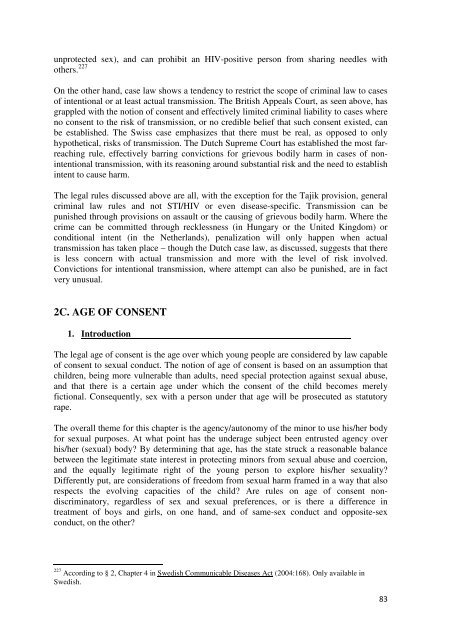Johanna Westeson - The ICHRP
Johanna Westeson - The ICHRP
Johanna Westeson - The ICHRP
You also want an ePaper? Increase the reach of your titles
YUMPU automatically turns print PDFs into web optimized ePapers that Google loves.
unprotected sex), and can prohibit an HIV-positive person from sharing needles with<br />
others. 227<br />
On the other hand, case law shows a tendency to restrict the scope of criminal law to cases<br />
of intentional or at least actual transmission. <strong>The</strong> British Appeals Court, as seen above, has<br />
grappled with the notion of consent and effectively limited criminal liability to cases where<br />
no consent to the risk of transmission, or no credible belief that such consent existed, can<br />
be established. <strong>The</strong> Swiss case emphasizes that there must be real, as opposed to only<br />
hypothetical, risks of transmission. <strong>The</strong> Dutch Supreme Court has established the most farreaching<br />
rule, effectively barring convictions for grievous bodily harm in cases of nonintentional<br />
transmission, with its reasoning around substantial risk and the need to establish<br />
intent to cause harm.<br />
<strong>The</strong> legal rules discussed above are all, with the exception for the Tajik provision, general<br />
criminal law rules and not STI/HIV or even disease-specific. Transmission can be<br />
punished through provisions on assault or the causing of grievous bodily harm. Where the<br />
crime can be committed through recklessness (in Hungary or the United Kingdom) or<br />
conditional intent (in the Netherlands), penalization will only happen when actual<br />
transmission has taken place – though the Dutch case law, as discussed, suggests that there<br />
is less concern with actual transmission and more with the level of risk involved.<br />
Convictions for intentional transmission, where attempt can also be punished, are in fact<br />
very unusual.<br />
2C. AGE OF CONSENT<br />
1. Introduction<br />
<strong>The</strong> legal age of consent is the age over which young people are considered by law capable<br />
of consent to sexual conduct. <strong>The</strong> notion of age of consent is based on an assumption that<br />
children, being more vulnerable than adults, need special protection against sexual abuse,<br />
and that there is a certain age under which the consent of the child becomes merely<br />
fictional. Consequently, sex with a person under that age will be prosecuted as statutory<br />
rape.<br />
<strong>The</strong> overall theme for this chapter is the agency/autonomy of the minor to use his/her body<br />
for sexual purposes. At what point has the underage subject been entrusted agency over<br />
his/her (sexual) body? By determining that age, has the state struck a reasonable balance<br />
between the legitimate state interest in protecting minors from sexual abuse and coercion,<br />
and the equally legitimate right of the young person to explore his/her sexuality?<br />
Differently put, are considerations of freedom from sexual harm framed in a way that also<br />
respects the evolving capacities of the child? Are rules on age of consent nondiscriminatory,<br />
regardless of sex and sexual preferences, or is there a difference in<br />
treatment of boys and girls, on one hand, and of same-sex conduct and opposite-sex<br />
conduct, on the other?<br />
227 According to § 2, Chapter 4 in Swedish Communicable Diseases Act (2004:168). Only available in<br />
Swedish.<br />
83
















